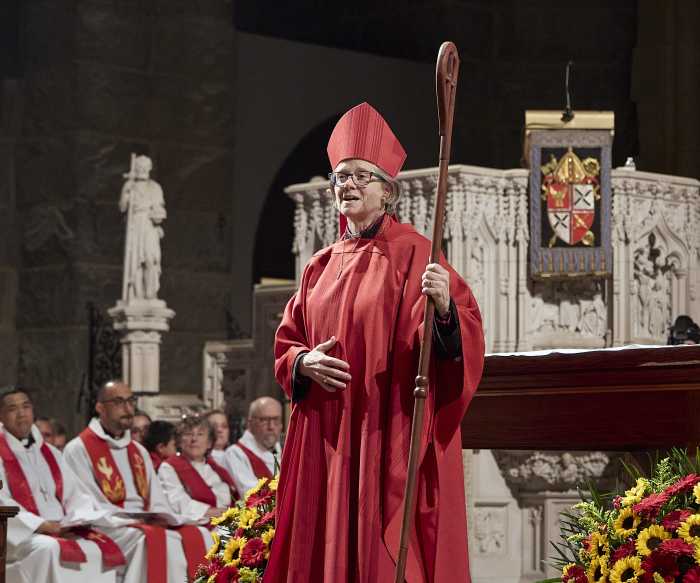Mayor Eric Adams joined elected officials, community representatives and New York City FC (NYCFC) players, staff and executives on Monday morning to cut the ribbon at NYCFC’s newly built mini soccer pitch at PS 211 Elm Tree Elementary School in Corona.
The ribbon-cutting marks the launch of a public-private partnership to build 26 mini soccer pitches across the five boroughs as part of the New York City Soccer Initiative (NYCSI), in celebration of the 2026 FIFA World Cup.
The initiative, a $3 million public-private partnership launched in 2016 between the Mayor’s Fund to Advance New York City, NYCFC, the U.S. Soccer Foundation and other partners, has already created 50 mini pitches across the city and offers free soccer programming and coaching throughout the five boroughs.
In 2021, following the opening of the 50th mini pitch, NYCSI committed to installing 26 more pitches in parks and schools throughout the city in honor of the 2026 FIFA World Cup being hosted in North America.
Monday’s ribbon-cutting marked the launch of the “26 for 26” program, with 25 more mini pitches set to be installed across the city over the next two years.
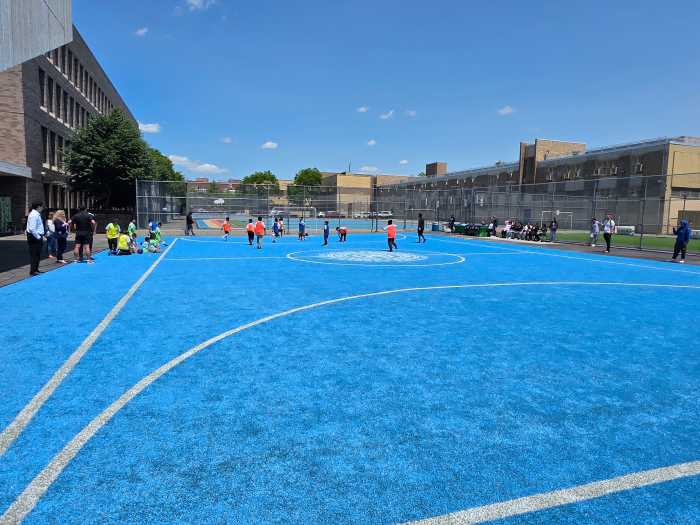
Adams joined Council Member Francisco Moya, NYCFC CEO Brad Sims, CEO of the NY/NJ World Cup Host Committee Alex Lasry and PS211 principal Kristen Niven at Monday’s ribbon-cutting at the school at 50-51 98th St., with a number of soccer-loving students also in attendance.
NYCFC first team coach Pascal Jansen and first team players Keaton Parks and Kevin O’Toole also joined for Monday’s event.
The first mini-pitch of the 26 for 26 campaign was installed thanks to a mix of public and private funding, including funds allocated by Moya, the Mayor’s Fund, NYCFC, and the club’s partners Capital RX and Etihad Airways.
Adams said it was fitting that the first of the new pitches was unveiled in Corona, given the close proximity to NYCFC’s new 25,000-seater soccer-specific stadium in Willets Point, stating that Queens will become a hub for the development of soccer throughout the city.
He also extolled the benefits of providing a space for children to play soccer in Queens, describing it as “more than just kicking a ball around.”
“It is where you develop long-term friendship partnerships. You learn how to work together, how to play together, how to communicate together,” Adams said at Monday’s ribbon-cutting.
Hizzoner later joined PS 211 students and NYCFC coaches for a kickabout on the newly laid surface, participating in passing and shooting drills.
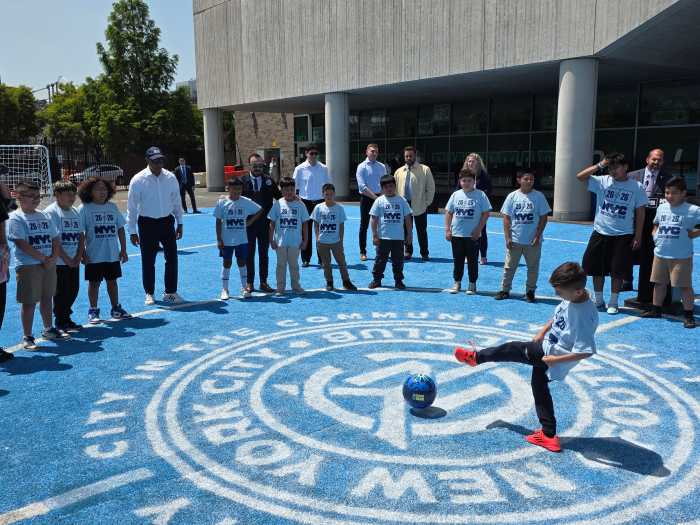
Moya, meanwhile, described soccer as a “global language” and added that every child in the city “deserves access to safe, high-quality space to play, to grow, and to thrive.”
“New York City Soccer Initiative is also sending a clear message; every child, no matter their zip code or background, deserves a chance to run on a quality field, to be coached, to build teamwork and to find joy. This is equity in action,” Moya said.
He also said the installation of the new pitch is “essential” to the local community, noting that his council district is the “most diverse district in the entire country.”
“What’s the one thing that brings everybody together? Football,” Moya said. ” I grew up here, and we didn’t have this… what we want to do is create the infrastructure that communities of color never have had (before).”
Parks and O’Toole, who are both ambassadors for City in the Community, NYCFC’s non-profit arm dedicated to providing safer spaces for youths to play soccer, said the new pitch will help inspire the next generation of soccer players while also helping to foster a culture of soccer in New York City.
O’Toole said the installation of pitches in communities across the city will help New York to capitalize on the rising popularity of soccer in the U.S. while also taking advantage of the sport’s momentum following next year’s World Cup.
“It’s a really unique opportunity to capitalize on the momentum of soccer in America,” O’Toole said.
He said children across the city will be inspired by “top players doing their thing” at the World Cup next summer and said facilities such as the new pitch in PS 211 provide them with a space to recreate their favorite moments from the tournament. He also said the pitches can help promote the sport amongst children in the city and help soccer compete with the big four sports in the US.
“It’s a beautiful facility. I wish I had this when I was in elementary school,” he added. “I think the chosen sport in the inner city is more basketball or football, and I think the more soccer fields that are available in these environments, the more connection there will be with the youth.”
Jansen said pitches such as the one installed at PS 211 is where a player’s journey can start, additionally noting that the installation of facilities and infrastructure is essential to capitalizing on the World Cup next summer.
“Having the World Cup come here is a massive thing, but this is where it starts,” Jansen said. “In order to have more kids playing football, which is the biggest sport in the world, you need to do these things in order to inspire them.”
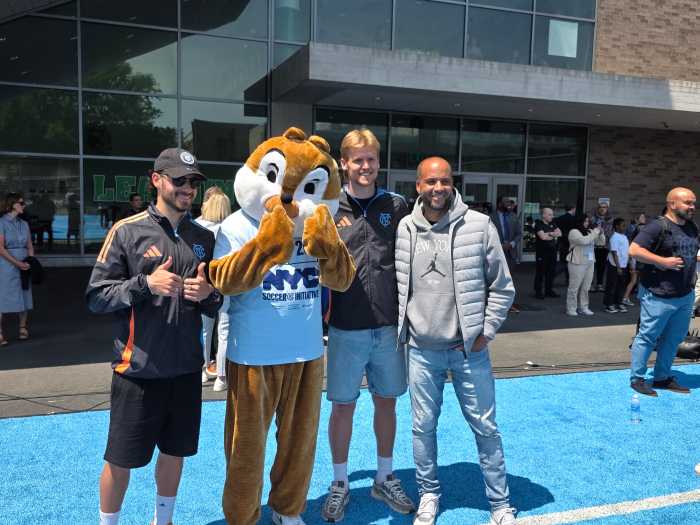
Sims, meanwhile, said NYCSI has installed pitches in 86% of the communities in New York City, adding that the new 26 for 26 campaign aims to bring that number closer to 100%. He said the initiative will focus on community board districts that do not currently have a mini pitch but said the 26 new pitches will be installed in parks and schools in each of the five boroughs.
Sims said the space constraints of New York City have actually proved advantageous, noting that the smaller pitches are more inclusive, allowing any number of friends to play on them.
“With 11 V 11 soccer pitches… you need 20 other people to be available to play a pickup game. Whereas with these mini pitches, it could be two kids, it could be four, six, eight, ten or 12. You can have groups of any size that could just grab a ball and go.”
Sims also believes that smaller pitches promote smaller-sized games, which are often encouraged by academies at the top clubs in the world to enhance technical development and tactical awareness.
He added that NYCFC will be working with PS 211 to provide free programming and coaching for local children on the new pitch, stating that the club has provided over 14,000 hours of free community coaching throughout New York over the past 12 months.
Bailee Eaglin, NYCFC’s director of community development, said the club has already seen the positive benefits from the 50 mini pitches installed as part of the first NYCSI campaign.
She said the pitches—and the free programming provided on them—give children an opportunity to connect with their peers and develop invaluable social skills.
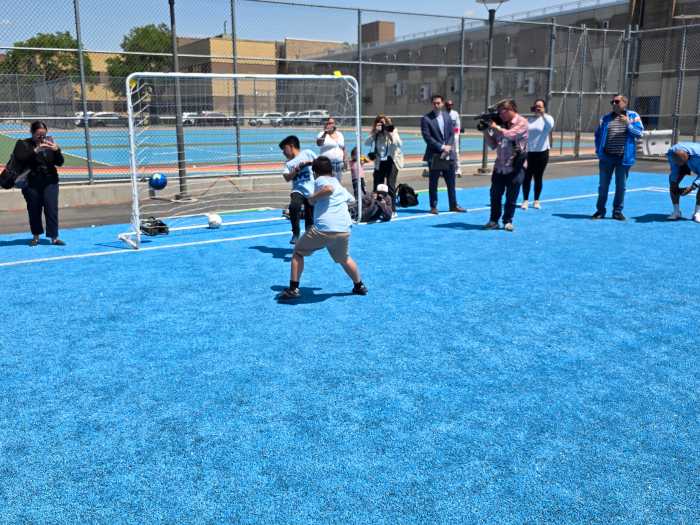
“The socialization opportunity is vast,” Eaglin said. “We have a lot of new arrivals in our programs and this is a tool for them to be themselves, to feel safe doing it, to connect with each other and to connect with their families.”
Niven similarly said the new pitch will allow students at PS 211 to “build teamwork, stay active and grow stronger in every way, physically, emotionally and socially.”
“When children have a safe, welcoming space to move and play and learn through sport, it builds their confidence and supports their overall development,” Niven said. “This is more than a field. It’s an investment in their future.”


































